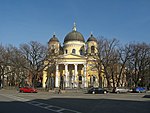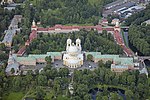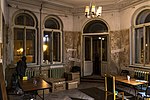Chernyshevskaya

Chernyshevskaya (Russian: Черныше́вская) is a station on the Kirovsko-Vyborgskaya Line of Saint Petersburg Metro, opened on September 1, 1958. It is a deep underground pylon station at 67 metres (220 ft) depth with a short central hall. The station is named after Chernyshevsky Prospekt, which is in turn named after Russian materialist philosopher and writer Nikolai Chernyshevsky. This station was part of the second stretch of the Saint Petersburg Metro built. While construction was about to start, a rule was created that no more stations should be ornately decorated, such as the stations between Avtovo and Ploshchad Vosstaniya (the first stretch built).
Excerpt from the Wikipedia article Chernyshevskaya (License: CC BY-SA 3.0, Authors, Images).Chernyshevskaya
проспект Чернышевского, Saint Petersburg
Geographical coordinates (GPS) Address Nearby Places Show on map
Geographical coordinates (GPS)
| Latitude | Longitude |
|---|---|
| N 59.9446 ° | E 30.3598 ° |
Address
проспект Чернышевского 20
191123 Saint Petersburg (округ Смольнинское)
Saint Petersburg, Russia
Open on Google Maps











